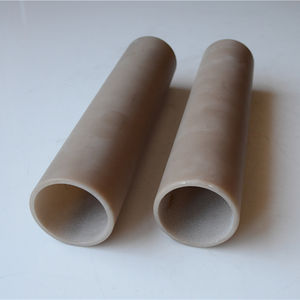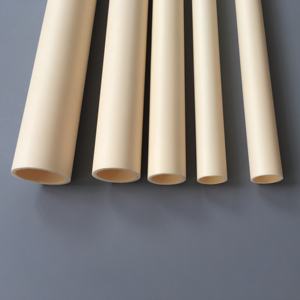1. Product Features and Architectural Layout
1.1 Structure and Crystalline Phases of Alumina
( Alumina Ceramic Tubes)
Alumina (Al Two O FIVE) ceramic tubes are mainly made from high-purity light weight aluminum oxide, with purity levels generally varying from 90% to 99.8%, depending upon the intended application.
The leading crystalline phase in fully thick, high-temperature sintered tubes is α-alumina (diamond), which exhibits a trigonal crystal framework and remarkable thermodynamic security.
This phase shift from forerunner hydroxides (e.g., boehmite or gibbsite) to α-alumina happens over 1100 ° C and causes a thick, interlacing microstructure that supplies superior mechanical stamina and chemical resistance.
Higher purity qualities (≥ 99.5%) take full advantage of hardness, use resistance, and dielectric efficiency, while lower-purity solutions might integrate secondary stages like mullite or glassy grain boundary phases to lower price or tailor thermal growth.
The ability to regulate grain dimension, porosity, and phase structure during handling enables designers to fine-tune alumina tubes for particular useful needs across diverse industrial domain names.
1.2 Mechanical, Thermal, and Electric Quality
Alumina ceramic tubes show an unique mix of physical homes that make them essential sought after design atmospheres.
With a Vickers hardness going beyond 1500 HV, they are highly immune to abrasion and erosion, outshining most steels and polymers in wear-prone systems.
Their compressive toughness can get to 2000 MPa, allowing structural usage under high mechanical lots, while flexural toughness usually ranges from 300 to 500 MPa, depending upon thickness and surface finish.
Thermally, alumina preserves security approximately 1700 ° C in oxidizing ambiences, with a reduced coefficient of thermal growth (~ 8 ppm/K), contributing to excellent thermal shock resistance when effectively made.
Although its thermal conductivity (~ 30 W/(m · K)) is moderate compared to metals or light weight aluminum nitride, it is sufficient for lots of high-temperature applications where electric insulation and structural stability are focused on.
Electrically, alumina is an exceptional insulator with quantity resistivity > 10 ¹⁴ Ω · centimeters and high dielectric toughness (> 15 kV/mm), making it suitable for electric feedthroughs, sensor real estates, and high-voltage insulation.
( Alumina Ceramic Tubes)
2. Manufacturing Processes and Dimensional Control
2.1 Shaping and Developing Techniques
The production of alumina ceramic tubes includes innovative forming techniques customized to accomplish specific measurements, wall surface density uniformity, and surface area top quality.
Usual techniques include extrusion, isostatic pressing, and slip casting, each suited to various dimension varieties and performance demands.
Extrusion is extensively used for long, straight tubes with consistent cross-sections, where a plasticized alumina paste is required with a die and cut to size prior to drying out and sintering.
For high-precision or thin-walled tubes, cold isostatic pressing (CIP) uses uniform stress from all directions to compact green bodies, minimizing distortion and boosting thickness homogeneity.
Slip spreading, entailing the deposition of a colloidal alumina suspension (slip) onto a porous plaster mold, is optimal for complex or large-diameter geometries with variable wall thickness.
After forming, tubes undergo mindful drying to avoid splitting, adhered to by binder burnout and high-temperature sintering (1500– 1650 ° C )to attain complete densification and dimensional security.
2.2 Ending Up and Quality Assurance
Post-sintering procedures such as centerless grinding, washing, and polishing are used to accomplish tight resistances, smooth surface coatings, and exact inner and outer diameters.
Resistances as limited as ± 0.01 mm are attainable for crucial applications in semiconductor handling or analytical instrumentation.
Surface area roughness can be reduced to Ra < 0.1 µm, decreasing fragment trapping and boosting compatibility with ultra-high vacuum (UHV) or cleanroom atmospheres.
Non-destructive testing approaches– consisting of ultrasonic evaluation, X-ray radiography, and color penetrant testing– ensure architectural integrity and absence of fractures or voids.
Dimensional assessment making use of coordinate measuring devices (CMM) or laser scanning validates conformity with design specifications, specifically for customized or high-volume manufacturing runs.
3. Useful Performance in Harsh Environments
3.1 Resistance to Thermal and Chemical Deterioration
One of one of the most engaging advantages of alumina ceramic tubes is their capacity to stand up to severe thermal and chemical problems where steels and polymers fail.
They remain dimensionally secure and mechanically robust in continual service at temperature levels above 1500 ° C, making them ideal for heater liners, thermocouple defense sheaths, and glowing heating system tubes.
Their inertness to thaw metals (e.g., aluminum, zinc, and non-ferrous alloys), molten salts, and several acids (except hydrofluoric and hot phosphoric acid) enables use in metallurgical and chemical handling tools.
In oxidizing and lowering ambiences, alumina does not weaken or catalyze unwanted reactions, maintaining procedure purity in semiconductor and glass production.
This chemical inertness also avoids contamination in high-purity liquid dealing with systems, including those used in pharmaceutical and food handling markets.
3.2 Electric Insulation and Plasma Resistance
In electrical and plasma settings, alumina tubes act as shielding barriers that keep circuit stability under high voltage and raised temperature.
They are utilized in high-intensity discharge (HID) lights, where they include ionized gases at temperature levels surpassing 1000 ° C while withstanding electrical potentials of a number of kilovolts.
In plasma etching and deposition systems, alumina tubes function as dielectric windows or gas distribution elements, resisting ion bombardment and thermal cycling without breaking or outgassing.
Their low dielectric loss and high arc resistance protect against electric monitoring and break down, making certain lengthy life span in switchgear and power transmission components.
These residential or commercial properties are critical in keeping process security and equipment integrity in advanced manufacturing and energy systems.
4. Industrial and Arising Applications
4.1 High-Temperature and Commercial Processing Solutions
Alumina ceramic tubes are indispensable to a large range of industrial procedures that demand durability under extreme conditions.
In thermal processing, they function as protective sheaths for thermocouples and heating elements in kilns, heating systems, and warmth therapy tools, shielding delicate components from destructive ambiences and mechanical wear.
In liquid handling, they move aggressive chemicals, slurries, and high-temperature gases in petrochemical refineries, desalination plants, and waste incineration systems.
Their resistance to thermal shock permits fast heating and cooling down cycles without failure, a vital advantage in cyclic commercial operations.
In glass manufacturing, alumina tubes direct liquified glass flows and assistance forming devices, resisting erosion from thick, high-temperature thaws.
4.2 Advanced Technologies and Future Combination
Beyond standard commercial uses, alumina tubes are locating new functions in sophisticated technologies.
In semiconductor construction, ultra-pure alumina tubes are utilized in chemical vapor deposition (CVD) reactors and ion implantation systems, where fragment generation and metal contamination must be reduced.
In medical devices, biocompatible alumina tubes function as insulating components in surgical devices, dental implants, and diagnostic sensing units.
Study is exploring functionalized alumina tubes with ingrained sensors or conductive traces for smart architectural tracking in aerospace and energy systems.
Additive manufacturing (3D printing) of alumina is becoming an approach to create intricate tube geometries with internal networks or graded make-ups, enabling next-generation heat exchangers and microreactors.
As sectors press toward greater effectiveness, cleaner procedures, and higher dependability, alumina ceramic tubes remain to evolve as enabling elements in the infrastructure of contemporary technology.
In recap, alumina ceramic tubes represent a fully grown yet dynamically progressing course of crafted materials, combining extraordinary thermal, mechanical, and electrical efficiency in a single not natural avenue.
Their versatility across severe atmospheres ensures their ongoing relevance in both established commercial systems and arising sophisticated applications.
5. Supplier
Advanced Ceramics founded on October 17, 2012, is a high-tech enterprise committed to the research and development, production, processing, sales and technical services of ceramic relative materials and products. Our products includes but not limited to Boron Carbide Ceramic Products, Boron Nitride Ceramic Products, Silicon Carbide Ceramic Products, Silicon Nitride Ceramic Products, Zirconium Dioxide Ceramic Products, etc. If you are interested, please feel free to contact us.
Tags: Alumina Ceramic Tubes, alumina tubes sizes, alumina tube
All articles and pictures are from the Internet. If there are any copyright issues, please contact us in time to delete.
Inquiry us






